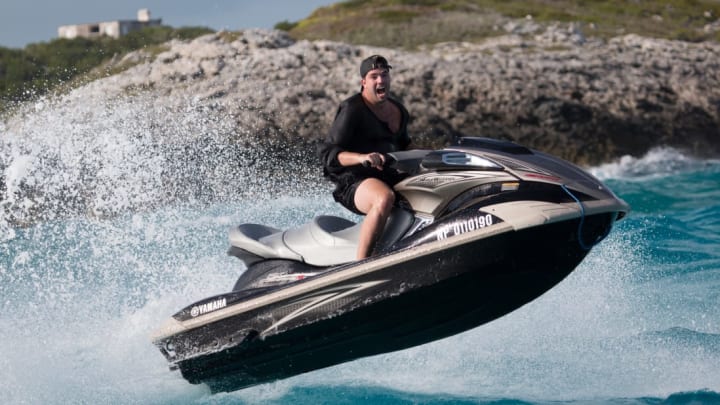Nearly two years after it engulfed the internet, the disastrous Fyre Festival was recently chronicled in two separate streaming documentaries. Fyre: The Greatest Party That Never Happened hit Netflix on January 18. It was preceded earlier that week by Fyre Fraud, which is streaming on Hulu. Both films examine the poor planning that led up to promoter Billy McFarland’s failed 2017 concert event on a Bahamian island that promised a premium experience and instead delivered cold cheese sandwiches and FEMA tents for housing. The entire fiasco was largely perceived as an indictment of Millennial materialism and the questionable coercion of social media influencers.
After viewing one or both films, viewers may still have some outstanding questions about the Fyre fallout. Here’s what we know about the wayward Woodstock and some of the lingering issues the documentaries raised.
1. Why did Billy McFarland participate in the Hulu documentary?
Billy McFarland—who is currently serving a six-year federal prison sentence for the wire fraud he perpetuated to raise money for the Fyre Festival—was conspicuously absent from Netflix’s Fyre, seen only in archival footage. Viewers of Fyre Fraud on Hulu, however, watched as McFarland sat for an interview and blinked into the camera. (He was filmed prior to his sentencing.) Though he didn’t offer much in the way of substance and issued a string of “no comments,” some people were surprised he chose to cooperate at all.
That participation, it turns out, was a matter of money. According to Fyre Fraud co-director Jenner Furst, McFarland was paid to sit for an eight-hour interview and share behind-the-scenes footage of himself and other festival planners. Furst would not disclose the exact amount they paid McFarland but told The Ringer it was less than the $250,000 figure being reported by some outlets. According to Chris Smith, director of the Netflix documentary, McFarland was also willing to sit for his film—for $100,000 in cash. Smith declined, feeling that it would be rubbing salt in the wound of the vendors and other individuals who had suffered financially as a result of the festival.
2. Did Pablo Escobar really own the island?
Fyre’s organizers and social media planners made considerable hay over the idea that the “private island” where they originally planned to hold the festival was once owned by Colombian drug kingpin Pablo Escobar. It’s not entirely clear why connecting the festival site to a notorious drug lord would be appealing, but in any case, it’s not actually true. The event was held on Great Exuma, which was never owned by Escobar. An Escobar associate, Carlos Lehder, once owned a neighboring island called Norman’s Cay, which Fyre organizers had originally wanted to use as the festival site.
3. Why was there so much available footage of the festival’s planning?
Chalk it up to the age of social media and a desire to chronicle every moment of what McFarland and his team expected to be a watershed moment in pop culture. Fyre hired Matte Projects, a production company, to follow them around and gather footage; Netflix’s film also utilized material shot by an employee at Jerry Media, the ad agency hired to promote the festival, who was filing a daily vlog of the company’s experiences with McFarland.
4. Did any attendees get a refund?

Some did—but not from Fyre. Many attendees paid between $500 to $2000 for admission, not including deposits to wristbands that were meant to facilitate a “cashless” weekend. Despite a rash of lawsuits, there are no reports of Fyre refunding ticket prices or settling court judgments. Instead, some fortunate customers contested the charges with their credit card companies and were able to get the transactions reversed.
5. Will these be the only two movies made about the festival?
Probably not. After the films premiered, actor Seth Rogen tweeted that he and The Lonely Island creators Andy Samberg, Jorma Taccone, and Akiva Schaffer were still working on a fictional feature film about a music festival that “goes horribly wrong.” It’s unclear whether the festival inspired the project, but at this point, it would be a hard thing for any screenwriter to ignore.
6. Did anyone actually get to swim with the pigs?

The wild, native pigs of Great Exuma were of great interest to Fyre organizers, who shot promotional footage of models frolicking with the oinking mascots. Later, reports of patrons being accosted by “wild animals” surfaced, though it’s unclear whether any festivalgoer was actually harmed by them. One attendee actually called encountering them the highlight of an otherwise miserable experience. “Fyre is a huge sh*t show but it hasn’t been a total loss. I got to meet [a] swimming pig yesterday,” he wrote.
